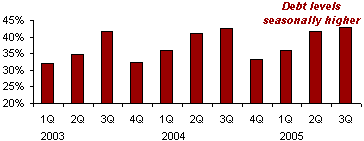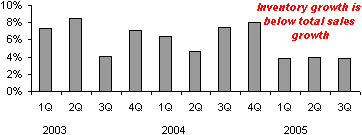IDEX Online Research: Retail Jewelers’ Balance Sheets Solid As Industry Heads Into Holiday Period
December 07, 05
As the industry heads into the all-important holiday selling season, most specialty jewelers have solid balance sheets. Debt levels at the end of the third quarter were at their seasonal high, but are at about the same level – 48 percent of capitalization – as last year. Inventory growth is at or below sales growth; this means that jewelers are not over-inventoried going into the holiday season. The risk - consumer demand could be stronger than anticipated, and jewelers might run out of hot merchandise.
Debt Levels In Line With Last Year
Debt levels are flattish to up modestly. Even though interest rates are up, it appears that retail jewelers’ debt levels are manageable. In short, retailers have done a good job of using vendor financing or memo goods to keep their jewelry displays full of product.
In contrast, debt levels further back in the diamond pipeline are at record levels. With rising interest rates, this does not bode well, especially if holiday season sales are weaker than expected.
The graph below illustrates current debt levels. Because jewelers’ business is seasonal, third quarter debt levels are typically the highest of the year to support new merchandise that has been brought in for the upcoming holiday season.
Composite Debt Levels
Publicly Held Retail Jewelers Percent of Capitalization
Source: Company reports
Inventory Growth Below Sales Gains
Bankers and financial analysts pay particular attention to the inventory-to-sales rate. If inventory levels are growing in line with sales increases, most lenders remain happy. This year, retail jewelers’ inventory growth at the end of the third quarter was below sales growth in the same period. In part, this is due to modest declines in inventory at both Zale and Tiffany. In the case of Zale, floods in India earlier this fall disrupted receipt of goods. Tiffany’s work-in-process inventories are down. If both companies had shown normal seasonal inventory growth, the inventory-to-sales ratio would have been exactly in line with sales growth.
On an annual basis, jewelers have kept their inventory growth at moderate rates. As the graph below illustrates, inventory growth in 2005 has been much lower than in the prior two years. With weak industry-wide sales, jewelers have been exercising caution by keeping inventory growth modest.
| Composite Inventory Growth |
If these trends continue, jewelers should have ample cash – or borrowing power – at the end of the holiday season. Thus, vendors can expect to be paid in a timely fashion by the typical U.S. jeweler.
